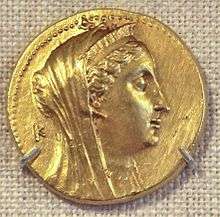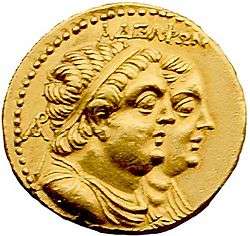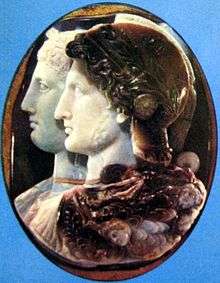Arsinoe II


Arsinoë II (Ancient Greek: Ἀρσινόη, 316 BC – unknown date between July 270 and 260 BC) was a Ptolemaic Greek Princess of Ancient Egypt. Through marriage she became Queen of Thrace, Asia Minor and Macedonia as wife of King Lysimachus (Greek: Λυσίμαχος), and later co-ruler of Egypt with her brother-husband Ptolemy II Philadelphus (Greek: Πτολεμαῖος Φιλάδελφος, "Ptolemy the sibling-loving").
Biography
Arsinoë was the first daughter of Pharaoh Ptolemy I Soter (Greek: Πτολεμαίος Σωτήρ, "Ptolemy the Savior"), founder of the Hellenistic state of Egypt, and his second wife Berenice I of Egypt.[1]
At about age 15, Arsinoë married King Lysimachus (who was then around 60 years old),[2] to whom she bore three sons: Ptolemy I Epigone,[3][4][5] Lysimachus[6] and Philip.[7] In order to position her sons for the throne, she had Lysimachus' first son, Agathocles, poisoned on account of treason. After Lysimachus' death in battle in 281 BC, she fled to Cassandreia (Greek: Κασσάνδρεια) and married her paternal half-brother Ptolemy Keraunos, one of the sons of Ptolemy I from his previous wife, Eurydice of Egypt. The marriage was for political reasons as they both claimed the throne of Macedonia and Thrace (by the time of his death Lysimachus was ruler of both regions, and his power extended to Southern Greece and Asia Minor). Their relationship was never good. As Ptolemy Keraunos was becoming more powerful, she decided it was time to stop him and conspired against him with her sons. This action caused Ptolemy Keraunus to kill two of her sons, Lysimachus and Philip, while the eldest, Ptolemy, was able to escape and to flee north, to the kingdom of the Dardanians. She herself went to Alexandria, Egypt to seek protection from her brother, Ptolemy II Philadelphus.

In Egypt, she continued her intrigues and probably instigated the accusation and exile of her brother Ptolemy II's first wife, Arsinoë I. Arsinoë II then married her brother; as a result, both were given the epithet "Philadelphoi" (Greek: Φιλάδελφοι, "Sibling-loving (plural)") by the presumably scandalized Greeks. Sharing in all of her brother's titles, she apparently was quite influential, having towns dedicated to her, her own cult (as was Egyptian custom), appearing on coinage and contributing to foreign policy, including Ptolemy II's victory in the First Syrian War between Egypt and the Seleucid Empire.
According to Posidippus, she won three chariot races at the Olympic Games, probably in 272 BC.[8][9]
After her death, Ptolemy II continued to refer to her on official documents, as well as supporting her coinage and cult. In establishing her worship as a goddess he justified his own cult.
See also
References
- ↑ "Did female Egyptian pharaoh rule before Cleopatra?". MSNBC. December 2, 2010. Retrieved 2010-12-05.
- ↑ Arsinoe of Egypt and Macedon: A Royal Life, Elizabeth Donnelly Carney, OUP USA, 2013 ISBN 9780195365511
- ↑ Billows, Kings and colonists: aspects of Macedonian imperialism, p.110
- ↑ Bengtson, Griechische Geschichte von den Anfängen bis in die römische Kaiserzeit, p.569
- ↑ Ptolemaic Genealogy: Ptolemy ‘the Son’, Footnotes 9 & 12
- ↑ Bengtson, Griechische Geschichte von den Anfängen bis in die römische Kaiserzeit, p.569
- ↑ Bengtson, Griechische Geschichte von den Anfängen bis in die römische Kaiserzeit, p.569
- ↑ Posidippus, P. Mil. Vogl. VIII 309, AB 78.
- ↑ Donnelly Carney, Arsinoe of Egypt and Macedon: A Royal Life, pag. 142.
Bibliography
- H. Bengtson, Griechische Geschichte von den Anfängen bis in die römische Kaiserzeit, C.H.Beck, 1977
- R.A. Billows, Kings and colonists: aspects of Macedonian imperialism, BRILL, 1995
- Elizabeth Donnelly Carney (2013). Arsinoe of Egypt and Macedon: A Royal Life. New York: Oxford University Press. ISBN 978-0-19-536551-1.
- Milan Papyrus, P. Mil. Vogl. VIII 309.
Further reading
- S.M. Burstein, "Arsinoe II Philadelphos: A Revisionist View", in W.L. Adams and E.N. Borza (eds), Philip II, Alexander the Great and the Macedonian Heritage (Washington, 1982), 197-212
- P. McKechnie and P. Guillaume (eds) Ptolemy II Philadelphus and his World. Leiden, 2008.
- M. Nilsson, The Crown of Arsinoë II: The Creation of an Image of Authority. Oxford, 2012.
- D. L. Selden, Daniel L. "Alibis". Classical Antiquity 17 (2), October 1998.
External links
| Wikimedia Commons has media related to Arsinoe II. |
- Coin with her portrait
- Encyclopædia Britannica
- Arsinoe II entry in historical sourcebook by Mahlon H. Smith
_Pentathlon.svg.png)